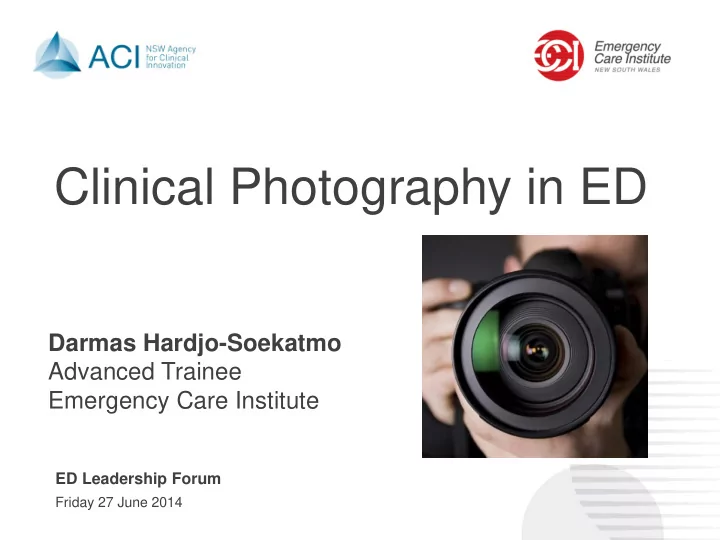

Clinical Photography in ED Darmas Hardjo-Soekatmo Advanced Trainee Emergency Care Institute ED Leadership Forum Friday 27 June 2014
Introduction • Common practice amongst Australian hospital clinicians • Widespread availability of digital cameras • Presence of digital cameras on electronic devices, especially smartphones • Smartphone take up of 49% in Australian population in May 2012
Current practice Burns K, Belton S. “Click first, care Barlow J. “Mobile phone use in second” photography Med J Aust Clinical Communication” SMACC 2012; 197 (5): 265 presentation 2014 • 170 clinicians • 47 critical care doctors • 48% have taken photographs • 51% have sent photographs from a mobile device • 20% used a personal mobile phone • 74% clinician had clinical photographs • Majority of clinicians photographed on a personal device 1-5 times per year • 49% obtained explicit consent • A minority of clinicians (including ED clinicians) photographed more frequently • 62% obtained consent, mostly verbal • 10% stored images on personal mobile phone
Current practice • Photographs are taken of patients, radiology and ECGs • Used for • Primary • Documentation • Telehealth (images transmitted using mobile phones to on call doctor) • Secondary • Education • Research • Publication
Evidence • Does camera phone photography improve patient care? • 2 studies involving patient images (2005, 2008) • Improves diagnostic accuracy • Avoids unnecessary transfer of patients • 5 studies involving radiology (2005-2013) • Findings mixed • Bedside ultrasound • X-rays • CT
What do patients think? Tomlinson J, Myers A, Meads B. Med J Aust Windsor JS, Rodway GW, Middleton 2013; 198 (1): 21-22 PM, McCarthy S. Digital photography. Postgrad Med J. 2006 Oct;82(972):688-92 . • Survey of 140 hand surgery patients • 97% agreed that camera phone photography may improve accuracy of Consent for use in 190 (92%) communication confidential medical records, medical • No patient disagreed with teaching and • sending a photograph of a wound or publication x-ray from the emergency Consent for use in 15 (7%) department to the on-call hand confidential medical specialist records and medical • use of clinical photographs in audit teaching only meetings and teaching Consent for use in 2 (1%) • intraoperative photos taken to assist confidential medical with planning of future treatment records only Refusal of consent 7
Benefits • Patients • Rapid access to specialist consultation and hence treatment • Patient comfort (no need for repeat removal of dressings) • Reduce need for repeat presentations for consultations, reducing travel time and cost • Clinicians • Facilitates timely decision making and disposition
Issues • Consent • Confidentiality • Image quality and authenticity • Ownership and storage
Consent • Wide variation in practice • Is consent required when the photograph is taken for primary purposes only? • If the patient is not identifiable, can the images be used for secondary purposes without explicit consent?
Confidentiality • Use of personal devices • Lost/ stolen devices • Transmission of images • Erroneous transmission • Connectivity of smartphones • Facilitates sharing of images among large numbers of people
Image Quality and Authenticity • Lighting • Editing • Colour correction • Resizing • Number of images • Image file type (RAW, TIFF, JPEG) • Interpretation of images • Colour • Dimensions • Depth • Watermark
Ownership and Storage • Who owns the photograph? • Institution where the photograph is taken • Medical records should be retained for 7 years • Image file type (RAW, TIFF, JPEG) • Integration into EMR • Currently possible but cumbersome • Wound care photography project • Storage space • No user friendly way of uploading photographs into our current EMR from a smartphone at present
Smartphone Applications • PicSafe https://picsafe.com/ • $50 per clinician per year • Separate information silo • Cloud storage • Cross border • Security • Figure1 https://figure1.com/ • Similar to PicSafe • For education • For registered clinicians only • Current EMR software to portable devices • Alternative EMR software
What should guidelines incorporate? • Documented informed consent (specify purpose for which photograph is taken) • Photographs should be stored in secure central database • Personal devices may be used but photographs should be deleted after use and storage
www.ecinsw.com.au Level 4, Sage Building , PO Box 699 T 02 9464 4674 www.ecinsw.com.au 67 Albert Avenue, Chatswood NSW 2067 Chatswood NSW 2057 F 02 9464 4728 ABN 89 809 648 636
Recommend
More recommend